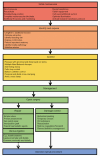Open management of massive venous bleeding in anterior lumbar spine surgery-a narrative review
- PMID: 41089919
- PMCID: PMC12516384
- DOI: 10.21037/jss-25-7
Open management of massive venous bleeding in anterior lumbar spine surgery-a narrative review
Abstract
Background and objective: Anterior lumbar spine surgery (ALSS) provides multiple benefits for the patient with spinal pathology. Vascular complications are uncommon and usually managed with simple surgical techniques and ancillary products. Rarely, confronting massive haemorrhage can occur after a venous injury which endangers the patient. We aimed to review the anatomical basis and risk factors for venous injury, propose a staged, systematic approach for management and discuss open surgical techniques, instruments, products, and strategies in detail for each of the stages.
Methods: This was a narrative review. A systematic approach was used. A review of national databases (PubMed, Ovid Medline, and Google Scholar) was performed using literature from 2000 to 2024 in English. Keywords included terms "anterior", "lumbar", "spine", "haemorrhage", "venous injury", "vascular", "repair", "ligation", "damage control", and "venous thromboembolism". Studies that aimed to describe the anatomy, risk factors, incidence, surgical techniques, complications, clinical and radiological outcomes of ALSS were included. Other generalised searches, not included in the initial systematic search, were conducted and included in our narrative review.
Key content and findings: This review considers the relevant anatomy, risk factors, patient work-up, lists possibly useful instruments and consumables, the broad stages of open management, specific operative strategies and techniques, and the post-operative management of the patient.
Conclusions: Massive venous injury (MVI) in ALSS is a rare but potentially life-threatening complication. Multiple open surgical techniques can be employed to control and manage the injury(s). The surgical and anaesthetic teams should have formulated a unified contingency plan against the eventuality of massive venous haemorrhage. The best outcome is only achieved with a team approach to the situation, recruitment of the necessary personnel and the deployment of the necessary equipment to enable the open management.
Keywords: Venous injury; anterior; haemorrhage; lumbar spine surgery; vascular repair.
Copyright © 2025 AME Publishing Company. All rights reserved.
Conflict of interest statement
Conflicts of Interest: All authors have completed the ICMJE uniform disclosure form (available at https://jss.amegroups.com/article/view/10.21037/jss-25-7/coif). The series “Anterior Lumbar Interbody Fusion — A Definitive Guide for Surgeons” was commissioned by the editorial office without any funding or sponsorship. G.M.M. serves as an unpaid editorial board member of Journal of Spine Surgery. Besides, G.M.M. reports consulting fees from Globus Medical, Australian Biotechnology and Life Healthcare, and supports for travel from Device Technologies, Life Healthcare, National Surgical, and SeaSpine. The authors have no other conflicts of interest to declare.
Figures
References
Publication types
LinkOut - more resources
Full Text Sources


